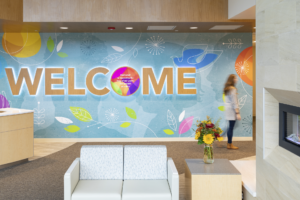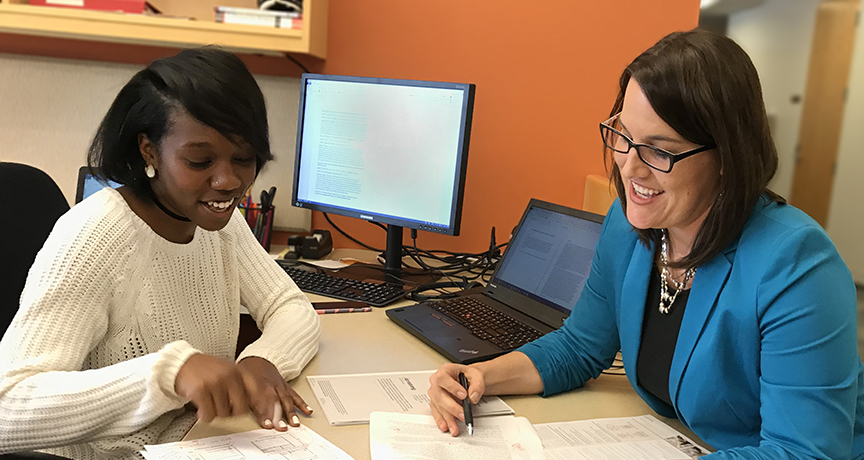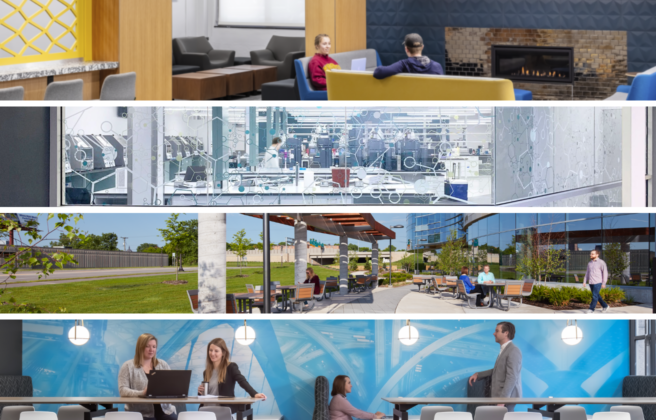Design can be a powerful tool to create change and impact organizations and communities. However, it is important that we are striving to understand through research exactly how the design of the built environment impacts our everyday lives. To this end, BWBR created a formal research and knowledge management program in 2007 which grew out of our vision to serve as a knowledge resource for our clients and to commit ourselves to developing a deeper understanding of the impacts that design has on occupants, on organizations, and within our communities.
In addition to our own research, BWBR finds research and collaboration opportunities through academic and student partnerships, such as the University of Minnesota School of Architecture’s Research Consortium and the Masters of Science and Research Practices program, known informally as the MSRP program. In this episode, BWBR Principal and Design Researcher Stefnee Trzpuc, CID, EDAC, LEED AP, connects with MSRP Program Director Professor Malini Srivastava, AIA, DDes (School of Architecture at the University of Minnesota), as well as former MSRP student Lucas Glissendorf (BWBR).
Harnessing the Combined Power of Academics and Industry
For Professor Srivastava, “The three criteria that I personally use [to define research] are originality, significance, and rigor.” Glissendorf adds: “It’s easy to talk about research and design as these separate methods of inquiry, but I think there’s so much about the research process that also happens in the design process. And that marriage of the two is really fascinating. A lot of the same things that make for a good research project also make for a good design process.”
Professor Srivastava explains why forging a connection between design firms and academic institutions is so powerful:
“The main goal of the MSRP program is to place students between academy and industry to address challenges that are in front of the built environment professionals. I think my greatest pleasure in the program is creating the right partnerships, taking student interests and passions and marrying them to firm needs.”
Professor Malini Srivastava, AIA, DDes
Glissendorf adds, “One of the foundational principles of the MSRP program is this idea of a continuous feedback loop between academic research and the work that’s happening in the professional practice environment. I think one of the greatest strengths of programs like this is the opportunity to engage in research that is incredibly timely and relevant to professional practice while also grounded in the rigor and the structure of academic research. One of the things that I really appreciated about working with the consortium was the incredible diversity of perspectives at the table, where we were all challenged to think about the problem in ways that might fall outside of our usual methods of inquiry.”
A Unique Approach Creates Shared Value
The MSRP program is unique in the way it pairs students, faculty advisors, and firm advisors to work together on common projects. This approach provides specific value to all participants and allows for creative breakthroughs that might not otherwise have been possible within the confines of a traditional project. Professor Srivastava elaborates, “I think there are a couple of really valuable things about the MSRP structure, where the students are in the middle of the academy and the firm. They’re being mentored and advised by people on both sides, and what they’re asked to do in return is ask deep questions. They’re given precious time to investigate something in depth, free of a project cycle, which gives them not only the time, but the permission to ask difficult questions.”
Participating firms also benefit by being able to ask questions that they have been wanting to ask, but haven’t had the time, resources, or expertise to tackle within their own corporate structure. Professor Srivastava elaborates, “Research methods are not a central part of professional training, but the kind of training that MSRP students get is actually implementing and developing expertise in research methodology. Rigorously collecting and analyzing data, and then being able to make sense of what that data shows, allows students to understand an issue from quite a different perspective. That methodology skillset then becomes another really important resource for firms to tap into.”
And while, in practice, firms are experts at what they do and have very advanced knowledge of their work, it’s not part of the traditional practice cycle to share and disseminate that knowledge, which is another benefit of partnerships like this.
The Future of Research in Practice
But what does the future of research hold? One important point of application is truly understanding and measuring the impact of our work. Glissendorf explains, “I’m a big believer in the idea that great design begins with asking great questions. I think research in practice is critical to understanding the impact that design and architecture can have on the organizations and communities that we serve and the social, economic, and environmental contexts within which we position our work. It’s really important to understand the impact our work can have, and to be able to communicate that in a really meaningful way.”
Professor Srivastava says: “We recently conducted research on the MSRP itself. We looked at all our past work, and the categories that emerged included climate change, clean water, sustainable ecosystem issues, and the social context within which we work.” These macro-trends will certainly continue to have an outsize impact on the industry, and research will continue to play a vital role in helping both firms and the academy understand and adapt to our changing circumstances.
Perhaps the biggest hope is for research and design to become ever more fully integrated. Professor Srivastava explains, “Design is not a one-time practice, it’s an ongoing practice. Buildings have long lives, which allow us to be involved from a design perspective over that lifetime, rather than just at the beginning. I’m hoping that the future of research and practice is that we understand the larger context and the role we play, whether it’s environmental or justice-related, and that we understand our part in the big picture.”








